MEET THE FAMILY
Introduction
BACK TO TABLE OF CONTENTS
A trout is a trout is a trout. Well - not quite. There are many fish going under the name of trout and some are not even in the same group (genus) as what we would call a trout. When we normally use the word trout we are probably referring to the rainbow trout or brown trout - and even these two come from different groups. The Latin name for the rainbow trout is Oncorhynchus mykiss (pronounced onk-or-ink-us my-kiss). Note that the genus deserves a capital letter but not the species type. To make matters even more complicated, the difference between trout and salmon can initially be somewhat confusing. There are about 24 species in the salmon and trout family, some of which migrate while others remain close to their place of birth for their whole lives.
Let’s see if we can make any sense of the family tree for the trout and salmon group. Karl Lineus first proposed the theory and practice of taxonomy - the grouping of creatures into their different families which is now a scientific study within itself. Each family is divided into various genus which represent closely related species and then further subdivided into the species themselves. Very closely associated species can even be further divided into subspecies. To give the complete picture here is a listing of how the tree of life is subdivided in its entirety:
THE TREE OF LIFE
Kingdom - animal, plant, fungi, protista (single cell micro-organisms) and monera (bacteria, blue-green algae and viruses)
Phylum (for animals) / Division (for plants)
Class
Order
Family
Genus
Species
Sub-species
This method of classification by hierarchy is known as systematics. All this organization gives us an interesting insight into how a group of animals - perhaps apparently disparate - might be related. The Latin name that covers the salmon and trout Family is Salmonidae. Under the rules of naming creatures - called binomial nomenclature - the genus name and the species name are used together as identifiers. The genus name is then shortened to just its first letter for ease of use. So our rainbow trout becomes O. mykiss. The use of italics indicates that a formal Latin name is being used. Reference would only be made to the family name of Salmonidae if there was likely to be confusion or to start an introduction and give clarity to a subject.
Finally, going one step further, the species may be divided into sub-species, normally determined by such differentiations as locale or some other unique characteristic which may have given rise to substantial variation from the accepted norm. Thus our O. mykiss may have a sub species such as coastal rainbow or Mexican rainbow.
The genus Onchorynchus includes not only many of the trout species but a majority of the salmon species as well. As well as Onchorynchus other genus in the Salmonid family are Salmo, Salvelinus and Hucho. The genus Salmo is mainly represented by the Atlantic salmon and the brown trout. The Atlantic salmon is found on both the Western seaboard of North America - primarily in Canada - and the European seaboard.
The brown trout has a much more diverse distribution, as we shall see, and is the Old World's contribution to the trout family. The genus Salvelinus is the Char family - which confusingly includes some species still called trout - and are found in the colder northern climes. Many of each family have now been introduced to other countries across the world. Finally, the genus Hucho are special landlocked fish species found in Eurasia.
We may never meet most of these fish and only a lucky few will have the opportunity to fish for them in their, often inhospitable, home waters, but it is still interesting to know all the members of the family. Here's how it all fits together.
GENUS ONCORHYNCHUS
The largest of the salmon and trout family, Oncorhynchus includes the New World species of salmon as well as many of the trout species. It is by far the largest of the three elements of the Salmonid family. There is also a great variety in the range and detail of each fish, as can be shown by the number of different sub species.
RAINBOW TROUT - O. MYKISS
There are about ten sub species of rainbow trout, whose sub species names mainly designate their distribution throughout North America, as follows:
Coastal Rainbow
Eagle Lake Rainbow
Golden Trout, Golden Trout Creek
Golden Trout, Little Kern River
Rainbow Trout, Kern River
Rainbow Trout of Mexico
Redband Columbia River
Redband Northern Great Basin
Redband Northern Sacramento River
Redband Sheepheaven
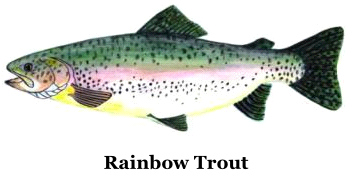 You will deduce from this list that the rainbow trout is of North American origin. Their original habitat is the fast flowing rivers west of the Rockies, which is why they do best in cold well oxygenated waters. Rainbow trout can acclimatize to lake and still water life and they are now widely stocked as the game fish of choice throughout the world. However, their origins dictate that they thrive best where the temperature of their habitat remains around 14 to 18 degrees centigrade. They will become stressed if the temperature rises substantially above this range and this is why we should seek them in deep water during the height of summer.
You will deduce from this list that the rainbow trout is of North American origin. Their original habitat is the fast flowing rivers west of the Rockies, which is why they do best in cold well oxygenated waters. Rainbow trout can acclimatize to lake and still water life and they are now widely stocked as the game fish of choice throughout the world. However, their origins dictate that they thrive best where the temperature of their habitat remains around 14 to 18 degrees centigrade. They will become stressed if the temperature rises substantially above this range and this is why we should seek them in deep water during the height of summer.
Rainbow are fine looking fish, having a deep r ed or vibrant pink bar running along the flank. With a dark green to olive back and a well spotted upper half which extends right through the tail, it is unlikely that you would mistake a rainbow trout for any other fish. Their size is very dependent upon their habitat and many fisheries now grow their stock on to enormous sizes. There seems no upper limit to which these monsters can be force fed! Some purists eschew these artificially reared fish but - as always - it's a matter of paying your money and taking your choice. I'm sure these big fish would not be offered if there was not a willing market for them.
ed or vibrant pink bar running along the flank. With a dark green to olive back and a well spotted upper half which extends right through the tail, it is unlikely that you would mistake a rainbow trout for any other fish. Their size is very dependent upon their habitat and many fisheries now grow their stock on to enormous sizes. There seems no upper limit to which these monsters can be force fed! Some purists eschew these artificially reared fish but - as always - it's a matter of paying your money and taking your choice. I'm sure these big fish would not be offered if there was not a willing market for them.
A wild rainbow will naturally grow to around a couple of pounds in a fast flowing river, and into the teens in a still water environment. The artificially reared record for the rainbow trout approaches 40 lb, while the naturally grown record stands at 24 lb 1 oz. I have been fortunate enough to catch more than fifteen wild rainbows over the ten pound mark with some approaching twenty, all naturally grown on from stock fish. Each one is a memory that makes it a very special occasion.
STEELHEAD TROUT
R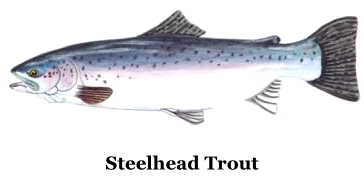 ainbow trout that choose to live the greater part of their lives at sea are called steelhead trout. These fish are described as anadromous - meaning that they live the larger part of their lives at sea, only entering the rivers to spawn. In this way the steelhead trout is more like the salmon varieties than its trout brethren. Steelhead are a highly prized game fish and many fishermen count a steelhead catch as the highlight of their fishing year. They are immensely strong as a result of their rich diet at sea and are described as a "bar of silver", which recognizes their startlingly bright appearance, often punctuated by an iridescent pink stripe down both flanks. As a point of interest, the opposite of anadromous is catadromous - fish which live most of their lives in fresh water, returning to the sea to spawn. The main example of a catadromous fish is the eel, which moves downstream and migrates to the Sargasso Sea in the western Atlantic Ocean to spawn.
ainbow trout that choose to live the greater part of their lives at sea are called steelhead trout. These fish are described as anadromous - meaning that they live the larger part of their lives at sea, only entering the rivers to spawn. In this way the steelhead trout is more like the salmon varieties than its trout brethren. Steelhead are a highly prized game fish and many fishermen count a steelhead catch as the highlight of their fishing year. They are immensely strong as a result of their rich diet at sea and are described as a "bar of silver", which recognizes their startlingly bright appearance, often punctuated by an iridescent pink stripe down both flanks. As a point of interest, the opposite of anadromous is catadromous - fish which live most of their lives in fresh water, returning to the sea to spawn. The main example of a catadromous fish is the eel, which moves downstream and migrates to the Sargasso Sea in the western Atlantic Ocean to spawn.
TRIPLOIDS
Many fisheries now stock a genetically modified type of rainbow trout called a triploid. Before you start worrying about the Frankenstein implications of this genetic tampering - relax! This alteration is achieved by exposing the eggs to high pressure during their development. This has the effect of ensuring that all the eggs develop as infertile fish - and the question is “Why”? It works something like this: genetic information - the genes - are stored in strings in tightly wound coils called chromosomes. A single set of chromosomes comes from the male fish - a single set is called a haploid set. But the female naturally produces eggs which are complete with two identical sets of chromosomes - the egg only becomes viable when one of these two sets of chromosomes gets replaced by the male set of chromosomes upon fertilisation.
A double set of chromosomes, whether the non-viable female double set or the viable male/female double set are called a diploid set. Fertilisation causes one of the female sets of chromosomes to be replaced by the male set and the extra female set gets re-absorbed into the egg. So far, so good. By exposing the eggs to a high pressure shortly after fertilisation the eggs are shocked and they fail to lose the extra set of female chromosomes. So they end up with three sets - called a triploid set. Effectively the fish carries one set of chromosomes from the male and two sets from the female. This triple set cannot divide to make a viable egg in the female or viable sperm in the male so triploid fish are infertile.
This inability to reproduce means that the males do not display the aggressive traits of territoriality and dominance, which makes for less fighting and stress within the fish population and a better fishery. The female fish do not become gravid and lose condition due to egg production, so their flesh remains firm and edible throughout the year. Triploidy also protects any indigenous fish population from cross-breeding and so avoids dilution of the gene pool of the local fish stock.
CUTTHROAT TROUT - O. CLARKI
T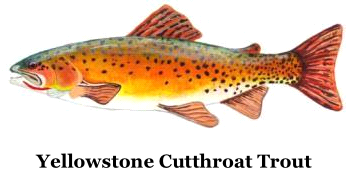 he Cutthroat Trout is widely spread across North America, as demonstrated by the large number of sub species.
he Cutthroat Trout is widely spread across North America, as demonstrated by the large number of sub species.
Alvord Cutthroat Trout
Bonneville Cutthroat Trout
Coastal Cutthroat Trout
Colorado Cutthroat Trout
Greenback Cutthroat Trout
Humboldt Cutthroat Trout
Lahontan Cutthroat Trout
Paiute Cutthroat Trout
Rio Grande Cutthroat Trout
Snake River Finespotted Cutthroat Trout
Westslope Cutthroat Trout
Whitehorse Basin Cutthroat Trout
Yellowfin Cutthroat Trout
Yellowstone Cutthroat Trout
C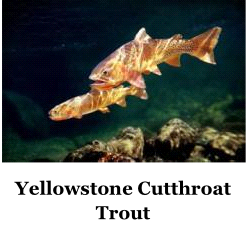 utthroat trout are an essentially North American fish. They require a fast flowing cold water habitat, so will not acclimatize to lake or reservoir existence. As their name implies they have a red or orange slash along the lower gill plate. Their black spots can be very variable and will cover the lower half of the body, unlike the rainbow trout. These spots tend to become more numerous towards the tail of the fish. While a very hard fighting and sporting fish, they do not attain the great size of the rainbow, due mainly to their more austere habitat. A good fish will weigh in at 5 lb, though they have been known, rarely, to grow to over 40 lb.
utthroat trout are an essentially North American fish. They require a fast flowing cold water habitat, so will not acclimatize to lake or reservoir existence. As their name implies they have a red or orange slash along the lower gill plate. Their black spots can be very variable and will cover the lower half of the body, unlike the rainbow trout. These spots tend to become more numerous towards the tail of the fish. While a very hard fighting and sporting fish, they do not attain the great size of the rainbow, due mainly to their more austere habitat. A good fish will weigh in at 5 lb, though they have been known, rarely, to grow to over 40 lb.
GILA TROUT - O. GILAE
Native in New Mexico and Arizona, this rare fish was placed on the endangered list in 1967. After concerted efforts to restore its original habitation it was downgraded to Threatened in 2006. Growing to about 18 inches in length, the fish is noticeably yellow in colour with small black spots on the upper half of its body. Limited fishing is now permitted in both States.
APACHE TROUT - O. APACHE
The state fish of Arizona, this fish is listed as Threatened on the Endangered Species List, having been under concerted conservation management since the 1940’s. Yellow/gold in colour, they have medium sized spots that may extend below the lateral line. There are two black spots placed either side of the eye and the fins may sport white or orange tips. Growing to around 20 inches in length with a weight of 5 lb in captivity, the wild fish is more likely to achieve less than 10 inches.
GOLDEN TROUT - O. AGUABONITA
Limited to the high waters of the S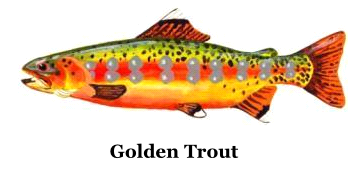 ierra Nevada Mountains in California, this is a very striking fish. It is one of the few trout that retains its vertical banding into adulthood - called parr markings. It runs around 1lb in the streams, but reaches about 10 lb in the lakes.
ierra Nevada Mountains in California, this is a very striking fish. It is one of the few trout that retains its vertical banding into adulthood - called parr markings. It runs around 1lb in the streams, but reaches about 10 lb in the lakes.

MEXICAN GOLDEN TROUT - O. CHRYSOGASTER
The Mexican Golden trout was declared an endangered species in 1996 and is not a target for fly fishing. Its habitat is the high elevation headwaters of the Mexican Sierra Madre.
THE PACIFIC SALMON FAMILY
This family includes all the famous North American salmon species but are still within the genus Onchorhynchus. Most salmon are also anadromous - spawning in fresh water but spending the majority of their lives at sea. Some landlocked fish have lost this trait but use large lakes to replace the sea, running into river or stream inlets to spawn.
CHINOOK - O. TSHAWYTSCHA
Also known as the King Salmon in Alaska, this fish is the larges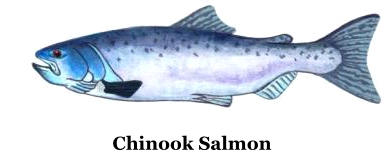 t of the salmon varieties and is greatly prized as a target for most game fishermen. Spending most of its life at sea, it migrates back up its river of birth to mate, spawn and die. This single spawning event separates the North American salmon varieties from its North Atlantic cousin, which can make several spawning runs throughout its life.
t of the salmon varieties and is greatly prized as a target for most game fishermen. Spending most of its life at sea, it migrates back up its river of birth to mate, spawn and die. This single spawning event separates the North American salmon varieties from its North Atlantic cousin, which can make several spawning runs throughout its life.
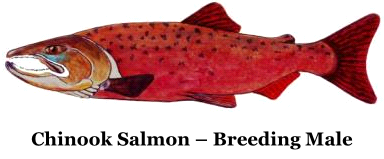 Chinook have a normal life cycle of four years but have never been as prolific as some of the other species. As with all salmon, they do not feed once they have entered the river system to start their spawning run. Yet they will still take a fly and this is normally ascribed to their naturally predatory nature. Sometimes confused with the coho, they can be identified by the all black mouth and tongue, as well as spots which cover both upper and lower lobes of its tail. There are now fresh water variants of the chinook living in the Great Lakes of North America. The average chinook will run to 12 lb but they are known to grow to over 120 lb.
Chinook have a normal life cycle of four years but have never been as prolific as some of the other species. As with all salmon, they do not feed once they have entered the river system to start their spawning run. Yet they will still take a fly and this is normally ascribed to their naturally predatory nature. Sometimes confused with the coho, they can be identified by the all black mouth and tongue, as well as spots which cover both upper and lower lobes of its tail. There are now fresh water variants of the chinook living in the Great Lakes of North America. The average chinook will run to 12 lb but they are known to grow to over 120 lb.

CHUM - O. KETA
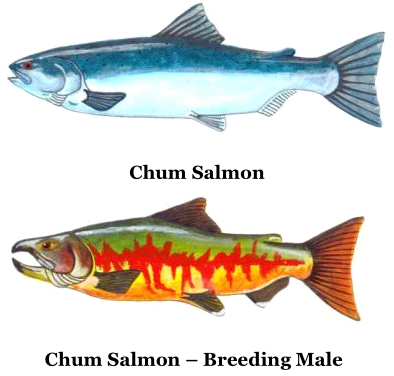 Sometimes called the dog salmon, these are very prolific but tend to grow to a smaller size than the chinook. Not as highly regarded as other salmon for sport, it can still offer a good fight. The nickname of dog salmon gives an indication of its less palatable taste. When caught, trappers would feed this fish to their dogs. Another theory for its derogatory nickname comes from the fearsome teeth it develops during its spawning run.
Sometimes called the dog salmon, these are very prolific but tend to grow to a smaller size than the chinook. Not as highly regarded as other salmon for sport, it can still offer a good fight. The nickname of dog salmon gives an indication of its less palatable taste. When caught, trappers would feed this fish to their dogs. Another theory for its derogatory nickname comes from the fearsome teeth it develops during its spawning run.
The sea run chum can be mistaken for the sockeye but they diverge dramatically in appearance once they start their spawning runs, with the sockeye turning bright red. Chum can be readily identified by the white tips to the pelvic and anal fins (the two fins on the underside of its body). The average size is around 7-10 lb but fish of over 30 lb have been known.
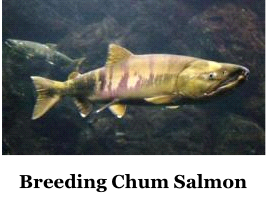
COHO - O. KISUTCH
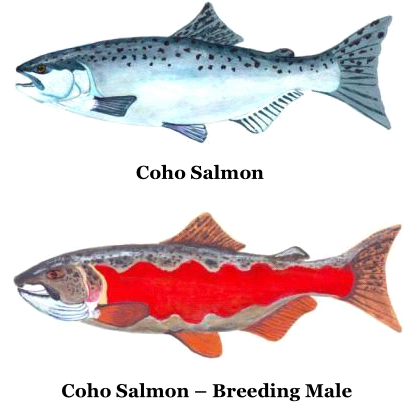 The coho salmon is also known as the silver and is widely distributed along the Pacific Seaboard of North America. It can be confused with a small chinook but there are differences which can aid identification. The inside of the mouth of the chinook is almost entirely black, while the coho will exhibit only occasional black patches. The tail on the coho is only spotted on its upper half, unlike the chinook. With an average weight of 8 lb, the maximum weight of the coho is around 30 lb. Coho, as well as chinook, are now prevalent in large bodies of freshwater, such as The Great Lakes, where they exhibit the same life cycle as their sea run counterparts, running up the rivers that flow into the lake to spawn.
The coho salmon is also known as the silver and is widely distributed along the Pacific Seaboard of North America. It can be confused with a small chinook but there are differences which can aid identification. The inside of the mouth of the chinook is almost entirely black, while the coho will exhibit only occasional black patches. The tail on the coho is only spotted on its upper half, unlike the chinook. With an average weight of 8 lb, the maximum weight of the coho is around 30 lb. Coho, as well as chinook, are now prevalent in large bodies of freshwater, such as The Great Lakes, where they exhibit the same life cycle as their sea run counterparts, running up the rivers that flow into the lake to spawn.
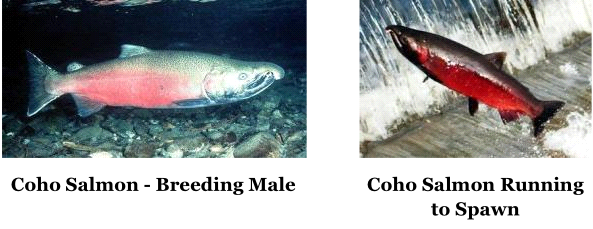
MASU - O.MASOU
This is an Asian variety of salmon, found in the north east corner of the continent - the Chinese and Russian Pacific seaboards. It is also known as the Cherry Salmon and it is easy to see why when the fish is seen in its breeding colours. It has both freshwater and migratory variants. It grows to about 10 lb.
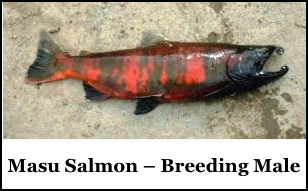
PINK - O.GORBUSHA
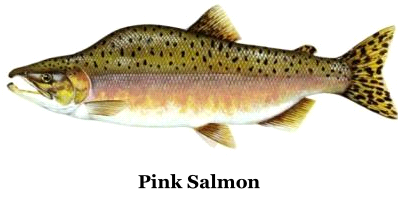 During its spawning run the male develops a pronounced humped back. This gives it the dubious alternative title of humpback or humpy. It is the most prolific Pacific species with a range extending from California to Alaska. Its huge abundance and the fact that its range extends farther south than other species gives it a commercial significance. Unlike other salmon, this variety only migrates a short distance upstream on its spawning run, often making its redd only a small distance above the highest tidal reach of the river. Maturing at two years, the average weight of the pink salmon is about 3-5 lb, although specimens have been caught in excess of 10 lb with the record standing at around 14 lb. Despite their small size compared to other salmon, they are a favourite target for sport fishermen.
During its spawning run the male develops a pronounced humped back. This gives it the dubious alternative title of humpback or humpy. It is the most prolific Pacific species with a range extending from California to Alaska. Its huge abundance and the fact that its range extends farther south than other species gives it a commercial significance. Unlike other salmon, this variety only migrates a short distance upstream on its spawning run, often making its redd only a small distance above the highest tidal reach of the river. Maturing at two years, the average weight of the pink salmon is about 3-5 lb, although specimens have been caught in excess of 10 lb with the record standing at around 14 lb. Despite their small size compared to other salmon, they are a favourite target for sport fishermen.
SOCKEYE - O. NERKA
 The North American Indians considered this fish so important that they named it "saukie", which means Chief of Fishes. It was used not only as food but also as a major form of barter. Its name comes to us today as the sockeye. Also known as the red salmon, the sockeye is not actively hunted as it rarely takes a fly or lure. It has a strong commercial significance and is striking for its spawning colours, which are bright red with a very hooked kype (lower jaw) in the males. Runs can be so numerous that some rivers are reputed to become crossable just walking on the brilliant red backs of the many thousands of fish thronging the shallows - but I think that is probably apocryphal. Even so, I have personally witnessed runs of sockeye of many, many thousands running up the Fraser River just south of Vancouver in British Columbia. It has a landlocked form known as the kokanee, which will fall to fly fishing methods. The sockeye grows to around 15 lb, but the kokanee is substantially smaller at around 5 lb.
The North American Indians considered this fish so important that they named it "saukie", which means Chief of Fishes. It was used not only as food but also as a major form of barter. Its name comes to us today as the sockeye. Also known as the red salmon, the sockeye is not actively hunted as it rarely takes a fly or lure. It has a strong commercial significance and is striking for its spawning colours, which are bright red with a very hooked kype (lower jaw) in the males. Runs can be so numerous that some rivers are reputed to become crossable just walking on the brilliant red backs of the many thousands of fish thronging the shallows - but I think that is probably apocryphal. Even so, I have personally witnessed runs of sockeye of many, many thousands running up the Fraser River just south of Vancouver in British Columbia. It has a landlocked form known as the kokanee, which will fall to fly fishing methods. The sockeye grows to around 15 lb, but the kokanee is substantially smaller at around 5 lb.

GENUS SALMO
This is the European contribution to the salmon and trout families. This Old World group of fish do not demonstrate the rigid life cycles of their American counterparts. Consequently, they tend to live longer lives with the salmon members sometimes returning from the sea to spawn several times.
ATLANTIC SALMON - S. SALAR
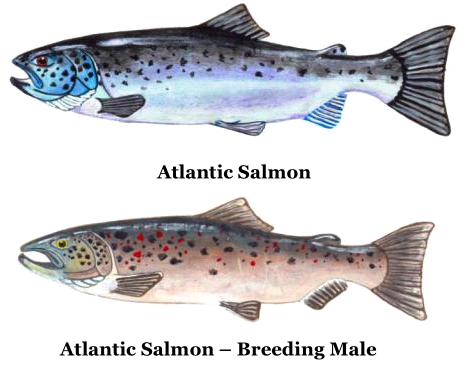 Whole books have been devoted to just this one species and the techniques for catching it. It is found along the Atlantic seaboard of Europe and northeast America and eastern Canada. The egg hatches into an alevin with a yolk sac still attached. The weight of the yolk sac keeps it anchored to the river bed during this early period, which in some respects resembles a larval stage of development. Having absorbed its yolk sac it then develops into the parr with distinctive vertical bars along its flank. It continues to live in the river for up to two years, when it becomes known as a smolt and migrates to sea where it feeds mainly on crustaceans.
Whole books have been devoted to just this one species and the techniques for catching it. It is found along the Atlantic seaboard of Europe and northeast America and eastern Canada. The egg hatches into an alevin with a yolk sac still attached. The weight of the yolk sac keeps it anchored to the river bed during this early period, which in some respects resembles a larval stage of development. Having absorbed its yolk sac it then develops into the parr with distinctive vertical bars along its flank. It continues to live in the river for up to two years, when it becomes known as a smolt and migrates to sea where it feeds mainly on crustaceans.
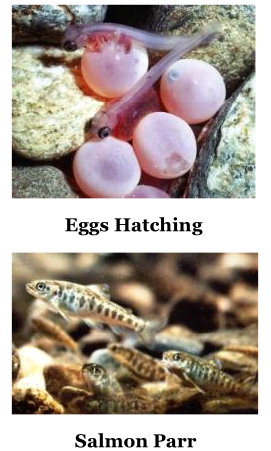 A fish that has had one winter at sea is known as a grilse or jack. It may return to spawn with the fully mature salmon and then run back to sea. While a jack will weigh around 9 lb, the three year old adult can weigh up to 70 lb. Cock (male) salmon develop a severely hooked jaw, known as a kype, during this spawning stage. Once each fish has selected its mate they use their tales to excavate a shallow trench, known as a redd, in the river bed. The female deposits her eggs in this redd and the male ejects his sperm, called milt, over the eggs to fertilise them. Once fertilised the eggs become rock hard to protect them during development.
A fish that has had one winter at sea is known as a grilse or jack. It may return to spawn with the fully mature salmon and then run back to sea. While a jack will weigh around 9 lb, the three year old adult can weigh up to 70 lb. Cock (male) salmon develop a severely hooked jaw, known as a kype, during this spawning stage. Once each fish has selected its mate they use their tales to excavate a shallow trench, known as a redd, in the river bed. The female deposits her eggs in this redd and the male ejects his sperm, called milt, over the eggs to fertilise them. Once fertilised the eggs become rock hard to protect them during development.
The redd is then covered over with gravel and the fish will protect the area for a period before moving off to repeat the process several more times. Unlike their Pacific cousins, the spawned Atlantic salmon, which is known as a kelt, may survive to return to the sea. They can undertake this spawning migration up to four times, but it must be said that only a small proportion of each year's run will survive.
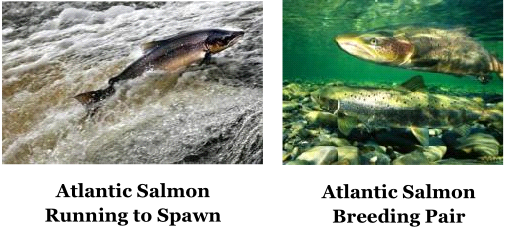
BROWN TROUT - S. TRUTTA
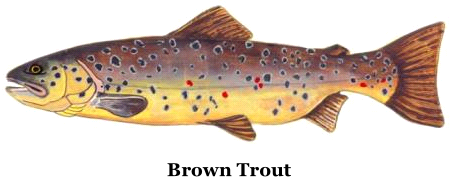 The most widely distributed of any trout sees this fish in North and South America as well as all across Europe and even as far afield as Australasia and India. This wide distribution is a result of the far flung reaches of the British Empire, especially those areas claimed during the reign of Queen Victoria. The viable eggs were transported across the world to create new populations everywhere the British Empire stretched. Effectively, the British ex-pats took their sport with them! The fish continued to be introduced to other countries and stocks now exist in such disparate places as South Africa, Chile and Argentina. In parts of North America it is known as the German brown in recognition of its European heritage. This North American version was started from a collection of 80,000 eggs from which 1,300 fish survived which had been taken from streams in the Black Forest in Germany.
The most widely distributed of any trout sees this fish in North and South America as well as all across Europe and even as far afield as Australasia and India. This wide distribution is a result of the far flung reaches of the British Empire, especially those areas claimed during the reign of Queen Victoria. The viable eggs were transported across the world to create new populations everywhere the British Empire stretched. Effectively, the British ex-pats took their sport with them! The fish continued to be introduced to other countries and stocks now exist in such disparate places as South Africa, Chile and Argentina. In parts of North America it is known as the German brown in recognition of its European heritage. This North American version was started from a collection of 80,000 eggs from which 1,300 fish survived which had been taken from streams in the Black Forest in Germany.
This most versatile fish now inhabits many still waters as well as running water from the smallest of brooks and streams right up to the largest of rivers. Additionally, it is stocked in many waters where it is not indigenous. Unlike the rainbow trout, the brown trout will readily spawn given a gravel bed and fresh running water. This makes it ideal for stocking purposes, although this argument is countered by the fact that it grows much more slowly than the rainbow.
Although highly variable, its body is normally brown with black and red spots scattered across it, spreading as far as the gill plate. These spots do not normally extend to the tail, which makes it a good rule of thumb when differentiating the brown trout from other trout and salmon species. Another distinguishing feature is that the hinge of the jaw is placed well past the eye in the brown compared to other Salmonid. The coloration will often be influenced by the fish's habitat. Where the local conditions cause the water to be dark or peat stained the fish will develop a much darker hue with larger black spots. Alternatively, a chalk stream variety is likely to be much paler in appearance. There are even populations known with bright yellow bellies and yet others that are nearly silver in appearance.

The eggs are laid in a gravel scrape, known as a redd, in a well oxygenated river or feeder spring if the population is lake-bound. They hatch after thirty days with the yolk sac still attached, when they are known as alevins. When the egg sac disappears they are known as fry, growing on to become parr which have banded markings on each side. They are sexually mature after three years.
Depending on environment the brown trout can grow from 1 lb to as much as 30 lb. As mentioned, they are much slower growing than their trout cousins such as the rainbow. This may be because of their much longer life span. A brown trout can live well into its teens, not reaching double figures in weight until ten years old or more. Brown trout are highly territorial, the strongest fish claiming the best feeding point. The very largest specimens become cannibalistic, feeding exclusively on fish, including their own kin. These demand special fishing techniques, as demonstrated on the loughs of Ireland where these monsters have developed into a sub species known as ferox trout.
SEA TROUT - S. TRUTTA
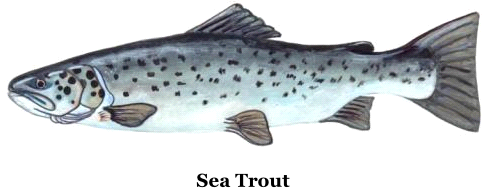 There is an anadromous (sea running) version of the brown trout. This form can be hard to distinguish from a salmon, especially if it has just entered the river system to spawn. However, there are a number of distinguishing features. It has a much thicker wrist - where the tail joins the body - and a sharply squared tail, whereas the salmon's tail is noticeably forked. Additionally the jaw of the sea trout is longer, extending past the fish's eye.
There is an anadromous (sea running) version of the brown trout. This form can be hard to distinguish from a salmon, especially if it has just entered the river system to spawn. However, there are a number of distinguishing features. It has a much thicker wrist - where the tail joins the body - and a sharply squared tail, whereas the salmon's tail is noticeably forked. Additionally the jaw of the sea trout is longer, extending past the fish's eye.
Some anglers devote themselves almost entirely to this sub species. They are among the most difficult fish to catch on a regular basis for several reasons. Their sea run life puts them out of reach of all but the most determined hunters for a good part of the fish's life. For much of the time they can only be found by trolling in the tidal areas of their home rivers prior to their spawning runs. Occasionally, they can be caught by spinning from the sea shore when they have moved in close to feed on crustaceans, lugworms and fry. They finally enter the river system which puts them within range of the fly fisherman.
 Sea trout share the same breeding and initial growth traits as the brown trout. Indeed it is impossible to differentiate the two in the early stages of life. The parr grow on and after two or three years become known as smolt. This is the time they make their journey to sea. A few will return to the river before they are sexually mature, when they are known as herling, but they don't stay long before returning to the ocean. At this time of immaturity they may also be called finnock, finnack or finnac depending on location.
Sea trout share the same breeding and initial growth traits as the brown trout. Indeed it is impossible to differentiate the two in the early stages of life. The parr grow on and after two or three years become known as smolt. This is the time they make their journey to sea. A few will return to the river before they are sexually mature, when they are known as herling, but they don't stay long before returning to the ocean. At this time of immaturity they may also be called finnock, finnack or finnac depending on location.
After two or three years they return to the river to spawn, when they are variously called grilse, peel, peal, sewin or sewen. They time their upstream runs to coincide with the tides and the full moon and always at night. This gives them their affectionate title of grey ghost. Once spawning is complete they are known as kelts and again move back to sea. While the mortality rate is high among spawned Atlantic salmon - sometimes as much as 90% - the sea trout enjoys a high survival rate.
Unlike salmon, the sea trout will continue to feed when it enters the river system to spawn. They can be taken with a floating line which should be allowed to swing round in the current before being stripped back quickly. The problem is that these fish are best caught at night and are very skittish and light shy. This makes them a real challenge to catch - at night, without lights and quietly - but that's part of the fun!
GENUS SALVELINUS
Though called the Char family, it constitutes a large part of the Trout family. Whereas the Onchorynchus and Salmo families are decorated with dark spots on lighter backgrounds, the reverse is true of the Chars.
BROOK TROUT - S. FONTINALIS
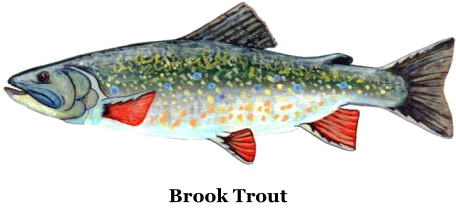 Originally from Eastern North America, this fish is now widely distributed. It has light wavy lines and blotches on its back and white edges to its belly fins. It also sports pinkish spots with a light blue halo on its sides, making it a strikingly beautiful fish. It requires cool well oxygenated water and has been successfully introduced to some moorland lakes and reservoirs.
Originally from Eastern North America, this fish is now widely distributed. It has light wavy lines and blotches on its back and white edges to its belly fins. It also sports pinkish spots with a light blue halo on its sides, making it a strikingly beautiful fish. It requires cool well oxygenated water and has been successfully introduced to some moorland lakes and reservoirs.
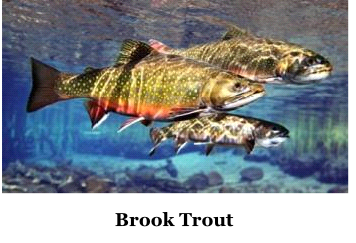 Where access to the sea is available, some variations are known to be diadromous – running to sea, not to spawn but staying close to their home river for several months before re-entering the river to spawn. A specific population of brook trout in Lake Superior run up the local rivers to spawn and this makes them potamodromous, living entirely in fresh water but still exhibiting a migratory nature. Growing to a normal weight of 5 lb, it has been known to reach nearly 15 lb.
Where access to the sea is available, some variations are known to be diadromous – running to sea, not to spawn but staying close to their home river for several months before re-entering the river to spawn. A specific population of brook trout in Lake Superior run up the local rivers to spawn and this makes them potamodromous, living entirely in fresh water but still exhibiting a migratory nature. Growing to a normal weight of 5 lb, it has been known to reach nearly 15 lb.
 The brook trout is occasionally crossed with the brown trout to produce the tiger trout, which possesses spectacular markings. Because it is a hybrid, the tiger trout is not afforded its own classification. It is also crossed with the lake trout to create the splake which is stocked in the Great Lakes.
The brook trout is occasionally crossed with the brown trout to produce the tiger trout, which possesses spectacular markings. Because it is a hybrid, the tiger trout is not afforded its own classification. It is also crossed with the lake trout to create the splake which is stocked in the Great Lakes.
BULL TROUT - S. CONFLUENTIS
Living in the northeast of North America, from the Yukon to northern California, this fish is similar in looks to the Dolly Varden. It inhabits cold deep rivers and lakes and is rarely anadromous. It has had a difficult history and is now the subject of concerted conservation efforts.
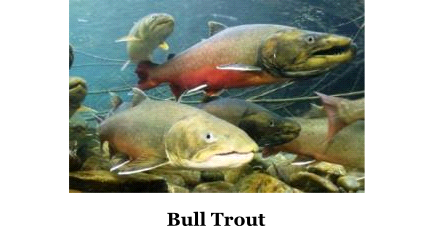
 Dolly Varden - S. malma
Dolly Varden - S. malma
Inhabiting the northern Pacific Rim, this silver fish sports white, pink and cream spots. It is known to grow to around 8 lb.
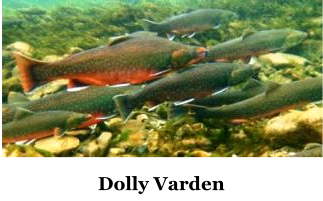
LAKE TROUT - S. NAMAYCUSH
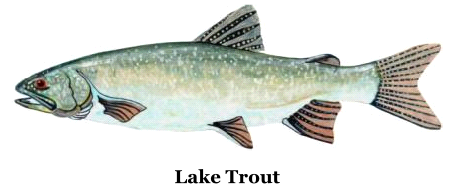 Preferring cold water, this freshwater fish inhabits the rivers and lakes of northern North America and Canada. It has also been introduced into areas of South America, Europe and New Zealand. Highly aggressive and cannibalistic, this slender fish has a brown body with white spots. It grows to around 40 lb, though specimens of over 100 lb have been reported.
Preferring cold water, this freshwater fish inhabits the rivers and lakes of northern North America and Canada. It has also been introduced into areas of South America, Europe and New Zealand. Highly aggressive and cannibalistic, this slender fish has a brown body with white spots. It grows to around 40 lb, though specimens of over 100 lb have been reported.
While these fish will approach the shallows at night it is more usual to fish for them in the depths with the use of a downrigger system - remember that some of lakes that hold these creatures can be 1,000 ft deep! The population of a particular lake can be quite small - a ten square mile lake may hold less that 50 fish, so it pays to adopt a mobile strategy when hunting this prey. It is common to troll using a boat with several rods in use set at various depths - one on a downrigger, one on a deep running line to search mid-water and one set to fish shallow. And you'll need big flies! This fish makes its living by eating other fish and will ignore anything less than jumbo size!
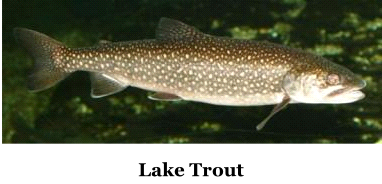
ARCTIC CHAR - S. ALPINUS
Taranets Char
Sunapee Char
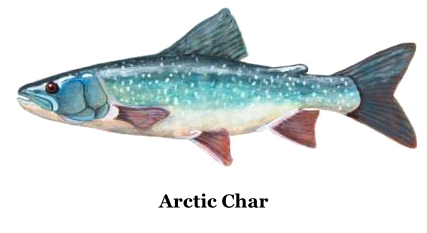 This fish inhabits all countries around the Arctic Circle, from Alaska through Northern Canada, Greenland, Iceland, Europe and on to Russia. The most northerly variants are anadromous growing up to about 25lb, although 10lb is more normal, while the southern counterparts will seek deep, cold lakes where they do not grow much beyond 8 lb, with 1½lb being the norm.
This fish inhabits all countries around the Arctic Circle, from Alaska through Northern Canada, Greenland, Iceland, Europe and on to Russia. The most northerly variants are anadromous growing up to about 25lb, although 10lb is more normal, while the southern counterparts will seek deep, cold lakes where they do not grow much beyond 8 lb, with 1½lb being the norm.
This is another species that has two distinct types - one that is lake-bound and one that is migratory. It may be that the lake-bound variant was separated from the sea at some time in the past when their access to the ocean was blocked by barriers created during siltage of previous waterways at the end of the last ice age. Alternatively, it may be that a migratory version of the fish found its way into the lakes by mistake when moving up river to spawn and stayed there. This trait is somewhat like the salmon found in the Great Lakes. And like those salmon, the lake-bound Char will use rivers flowing into their lakes as spawning areas. The Great Lakes version of the char is also known as the togue, while a smaller red bellied species found in the Welsh lakes of the United Kingdom is known as the torgoch.
 Migratory Arctic Char are found in high latitude rivers of the Northern Hemisphere, specifically from around 42° N to 82° N and mainly in the rivers of Alaska, Northern Canada, Greenland, Iceland and Siberia. After hatching in their home river they spend the first two years of their lives there before migrating to sea, where they will move in large shoals feeding on sand eels, smelt, herring and prawns. They will run back to spawn in late autumn or early spring, when they come within the range of the fly fisherman. But you have to make a conscious decision to hunt these fish - their habitat is far away from civilisation and will mean a dedicated holiday to catch them.
Migratory Arctic Char are found in high latitude rivers of the Northern Hemisphere, specifically from around 42° N to 82° N and mainly in the rivers of Alaska, Northern Canada, Greenland, Iceland and Siberia. After hatching in their home river they spend the first two years of their lives there before migrating to sea, where they will move in large shoals feeding on sand eels, smelt, herring and prawns. They will run back to spawn in late autumn or early spring, when they come within the range of the fly fisherman. But you have to make a conscious decision to hunt these fish - their habitat is far away from civilisation and will mean a dedicated holiday to catch them.
The lake-dwelling Arctic char is slightly more available in that they are accessible in their lakes during the time that the water is unfrozen. These lakes can be huge and very deep. It is usual to fish for them by boat with downriggers or other deep fishing equipment. Remember that these lake-bound fish will use the rivers running into the lake to spawn and this is another method of fishing for this species. They will hold in the deeper parts of the river on their way to the spawning grounds where they will build redds just like their salmon cousins.
Arctic char are stunningly beautiful fish with a belly that is flushed from deep pink to bright orange. The back can be from steely blue to brown or grey and carries numerous pale spots - the reverse of salmon where the spots are darker than the background. A deeply forked tail and white edgings to its fins are other defining characteristics of this fish.
GENUS HUCHO
These two species are Eurasian and both are landlocked in their respective locales.
Huchen - H.hucho
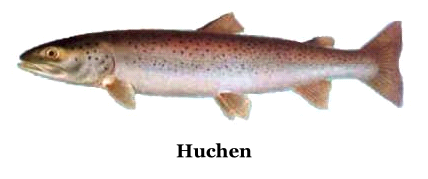 Found in the Danube basin, it is protected in many areas and if caught accidentally should be returned immediately. However, it has now been successfully introduced to several rivers in France.
Found in the Danube basin, it is protected in many areas and if caught accidentally should be returned immediately. However, it has now been successfully introduced to several rivers in France.
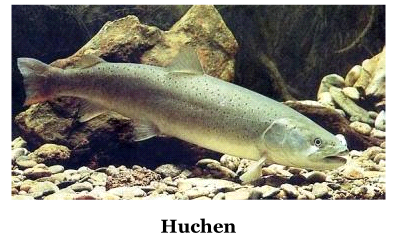
Taimen - H.taimen
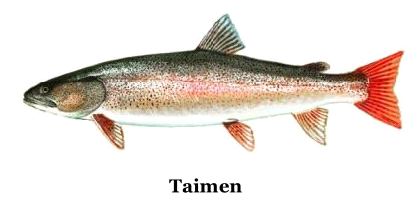 Found in the river Volga and its tributaries, as well as Siberia, this fish is a monster. Known to grow to over two hundred pounds, the current record is just under 100lb. They are caught on a fly, but their rarity and endangered status has been recognised in a universal catch and release policy.
Found in the river Volga and its tributaries, as well as Siberia, this fish is a monster. Known to grow to over two hundred pounds, the current record is just under 100lb. They are caught on a fly, but their rarity and endangered status has been recognised in a universal catch and release policy.
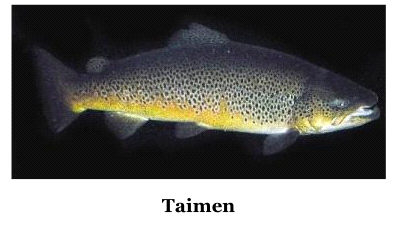

That’s a diver behind the fish!
BACK TO TOP
TABLE OF CONTENTS
